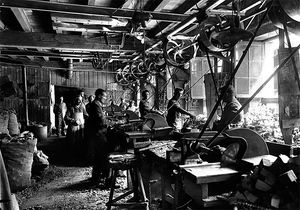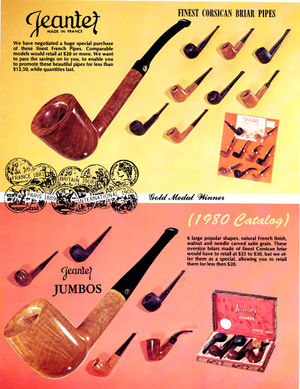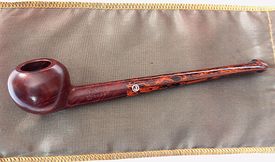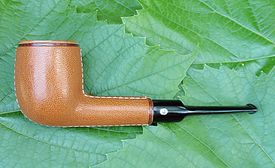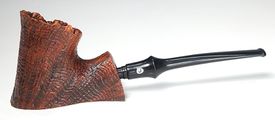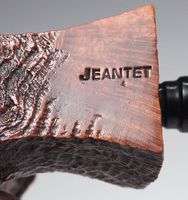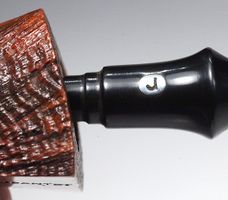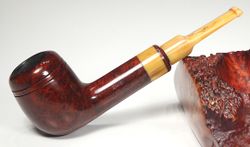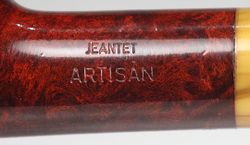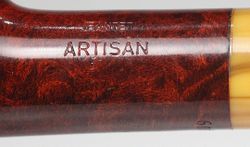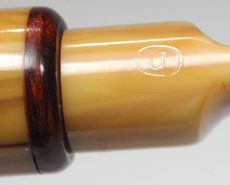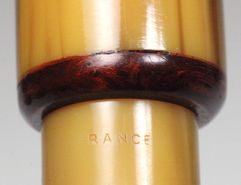Jeantet: Difference between revisions
No edit summary |
No edit summary |
||
| (7 intermediate revisions by 4 users not shown) | |||
| Line 1: | Line 1: | ||
The firm of the [[Jeantet]] family in [[Saint-Claude]] is first mentioned as early as 1775. By 1807 the Jeantets operated a turnery producing in particular wooden shanks for porcelain pipes and wild cherry wood pipes. The firm was named '''Jeantet-David''' in 1816, and in 1837 the enterprise was transformed into a corporation as collective name for numerous workshops scattered all over the city. | |||
[[File:Jeantet-factory20s.jpg|thumb|left|Circa 1920s factory, courtesy Doug Valitchka]][[File:Jeantet 1980 cat.jpg|thumb|1980 Jeantet Catalog, courtesy Doug Valitchka]]The manufacturing of briar pipes and began in 1858. 51 persons were employed by 1890. Desirous to concentrate the workers at a single site, the corporation began to construct a factory edifying integrated buildings about 1891 at Rue de Bonneville 12 - 14. This took several years. In 1898 '''Maurice Jeantet''' restructured the business. He is also presumed to enlarge Jeantet factory purchasing a workshop adjoining southerly. It belonged to the family Genoud, who were specialized in rough shaping of stummels and polishing finished pipes. ''(In these times it was a most common procedure to carry goods from here to there and back again often for certain steps of the production executed by dependant family based subcontractors. Manpower was cheap.)'' | |||
Jeantet was transformed to a corporation with limited liability in 1938. By that time a branch workshop was operated in Montréal-la-Cluse (Ain), where mainly the less expensive pipes were finished. 107 employees - 26 of them working from their homes - were counted in Saint-Claude in 1948 and 18 in the Ain facility. | |||
The Saint-Claude factory was considerably modernized by ca. 1950 installing (e.g.) freight elevators. In 1952 the southern workshop was elevated. 80 workers were employed in 1958. The factory covered an area of 2831 m²; 1447 m² of the surface were buildings. | |||
' | The climax of the pipe production was reached around 1969, when thirty to thirtyfive thousand dozens of pipes were made by 72 workers (1969). But then the production continously dwindled to only six or seven thousand dozens in 1987 and only 22 workers were still there. Eventhough, around 1979 a very modern steam powered facility for drying the briar had been installed in the factory's roofed yard. | ||
'''Yves Grenard''', formerly Jeantet's chief designer and a great cousin of '''Pierre Comoy''', had taken over the management of '''Chapuis-Comoy''' in 1971. Now, to preserve the brand, the Jeantet family went into negotiations with him, and resulting from that Jeantet was merged in the '''Cuty Fort Group''' (est. 1987 and headed by [[Chacom]]) in 1988 along with the pipe brands of John [[Lacroix]] and Emile [[Vuillard]]. Chacom closed the Jeantet plant, and the City of Saint-Claude purchased it in 1989. After alternative plans failed, the buildings were devoted to wrecking. The southerly workshop was wrecked before 1992. | |||
Today Jeantet pipes were produced as a sub-brand by Chapuis-Comoy who's mainstay is Chacom of course. | |||
<center><gallery widths=275px heights=200px> | |||
File:Jeantet.jpg | |||
File:2021-01.jpg | |||
File:2020-1-1.jpg | |||
</gallery> | |||
<gallery widths=275px heights=200px caption="Interesting freehand example and details, courtesy Doug Valitchka"> | |||
File:Jeantet01.jpg | |||
File:Jeantet07.jpg | |||
File:Jeantet08.jpg | |||
</gallery></center> | |||
<gallery widths=250px heights=185px caption="Artisan Example and details, courtesy Doug Valitchka"> | |||
Jeantet2-01.jpg | |||
Jeantet2-07.jpg | |||
Jeantet2-08.jpg | |||
Jeantet2-09.jpg | |||
Jeantet2-16.jpg | |||
</gallery> | |||
'''[http://www.patrimoine-de-france.org/oeuvres/richesses-36-11758-81701-M112605-201788.html French source] | |||
[[Category: Pipe makers by nationality]][[Category: France]] | [[Category: Pipe makers by nationality]][[Category: France]] | ||
Latest revision as of 12:22, 5 December 2020
The firm of the Jeantet family in Saint-Claude is first mentioned as early as 1775. By 1807 the Jeantets operated a turnery producing in particular wooden shanks for porcelain pipes and wild cherry wood pipes. The firm was named Jeantet-David in 1816, and in 1837 the enterprise was transformed into a corporation as collective name for numerous workshops scattered all over the city.
The manufacturing of briar pipes and began in 1858. 51 persons were employed by 1890. Desirous to concentrate the workers at a single site, the corporation began to construct a factory edifying integrated buildings about 1891 at Rue de Bonneville 12 - 14. This took several years. In 1898 Maurice Jeantet restructured the business. He is also presumed to enlarge Jeantet factory purchasing a workshop adjoining southerly. It belonged to the family Genoud, who were specialized in rough shaping of stummels and polishing finished pipes. (In these times it was a most common procedure to carry goods from here to there and back again often for certain steps of the production executed by dependant family based subcontractors. Manpower was cheap.)
Jeantet was transformed to a corporation with limited liability in 1938. By that time a branch workshop was operated in Montréal-la-Cluse (Ain), where mainly the less expensive pipes were finished. 107 employees - 26 of them working from their homes - were counted in Saint-Claude in 1948 and 18 in the Ain facility.
The Saint-Claude factory was considerably modernized by ca. 1950 installing (e.g.) freight elevators. In 1952 the southern workshop was elevated. 80 workers were employed in 1958. The factory covered an area of 2831 m²; 1447 m² of the surface were buildings.
The climax of the pipe production was reached around 1969, when thirty to thirtyfive thousand dozens of pipes were made by 72 workers (1969). But then the production continously dwindled to only six or seven thousand dozens in 1987 and only 22 workers were still there. Eventhough, around 1979 a very modern steam powered facility for drying the briar had been installed in the factory's roofed yard.
Yves Grenard, formerly Jeantet's chief designer and a great cousin of Pierre Comoy, had taken over the management of Chapuis-Comoy in 1971. Now, to preserve the brand, the Jeantet family went into negotiations with him, and resulting from that Jeantet was merged in the Cuty Fort Group (est. 1987 and headed by Chacom) in 1988 along with the pipe brands of John Lacroix and Emile Vuillard. Chacom closed the Jeantet plant, and the City of Saint-Claude purchased it in 1989. After alternative plans failed, the buildings were devoted to wrecking. The southerly workshop was wrecked before 1992.
Today Jeantet pipes were produced as a sub-brand by Chapuis-Comoy who's mainstay is Chacom of course.
- Interesting freehand example and details, courtesy Doug Valitchka
- Artisan Example and details, courtesy Doug Valitchka
